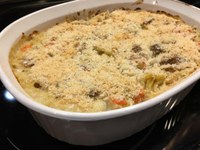Prairie Fare: Always Compliment the Cook Who Uses Planned-over Food
(Click an image below to view a high-resolution image that can be downloaded)
By Julie Garden-Robinson, Food and Nutrition Specialist
NDSU Extension Service
“What do you think?” my husband asked as I took a taste of the piping hot casserole.
“It’s kind of bland. It needs more pepper,” I said a little too quickly.
I noticed his expression resembled that of a sad puppy. I had criticized the entree he made.
Note to self: Always compliment the cook.
“But it’s good overall,” I quickly added as I sprinkled more pepper on top of the turkey tetrazzini casserole made with our Thanksgiving leftovers.
“Yes, that’s better,” he noted after adding more pepper to his own portion.
Let’s take a step back in time. When we were married in 1993, I introduced him to the northwestern Minnesota cuisine of the Norwegian-American variety from my childhood. In those early years, he sampled tater tot hot dish, rice hot dish, scalloped potatoes and other comforting one-dish meals. Yes, they were quite “bland” in color and flavor, compared with other cuisine.
He wasn’t particularly impressed with those early meals. He wouldn’t say anything, but he would go to the fridge during dinner. He’d return with the hot pepper sauce and drip it over most casseroles.
People of German ancestry must like more spice, I thought to myself back then. I guess I have converted my husband’s palate through these almost 25 years.
As we prepared food for our growing family, we always have been careful about tossing food. Our parents grew up during lean times in the U.S. and they passed along their frugal habits, which is a good thing. We use our leftovers in a variety of ways.
Unfortunately, leftovers often have a bad reputation. They may get forgotten in the back of your refrigerator and later thrown out. Instead of letting them go to waste, you can turn extra food items into planned-overs.
For example, during the upcoming holiday season, you might have roast turkey or chicken. Shred the planned-over roasted poultry, add some mayonnaise, chopped celery and spices and use it to make sandwiches. Or add some salsa and use it for chicken tacos. Simmer it with barbecue sauce and make sandwiches. Make some chicken-vegetable soup or a pot pie.
If you make spaghetti sauce with meat, use the remaining sauce to make lasagna or homemade pizza, or freeze it for a quick dinner later.
If you cook a beef roast, use the planned-over meat to make soup, stew or stir-fry. Shred it, add some barbecue sauce and serve it on buns.
If you decide to cook large quantities, be aware that perishable food can become a food safety issue if it is not cooled promptly. Most foods, including meat, casseroles, rice, beans, baked potatoes, cooked vegetables, and cut-up fruit and vegetables, are perishable. Perishable foods should spend no more than two hours at room temperature. Use refrigerated planned-over foods within a few days.
To keep your planned-overs safe, divide large amounts of leftovers into small, shallow containers for quick cooling. Slice meat into smaller pieces. Thick foods, such as stew, should be no more than 2 inches deep in a shallow container. Freeze planned-overs in recipe-sized portions. Label the container with the date and type of food.
Here’s the turkey casserole. It’s creamy and comforting. You can adjust the amount of pepper to your taste and the amount of salt to suit any sodium restrictions.
Turkey Tetrazzini
1 (8-ounce) package thin spaghetti, cooked as directed
1 Tbsp. butter
1/2 c. finely chopped onion
1/2 c. finely chopped celery
3/4 c. carrots (matchstick size)
1 c. sliced mushrooms (optional)
1/2 tsp. ground pepper (or more to taste)
1/2 tsp. salt
1/2 c. flour
1/2 c. white wine (or sherry)
4 c. chicken broth, reduced sodium
4 ounces light cream cheese (low fat)
1 c. Parmesan cheese (divided to use 1/2 cup first)
3/4 c. frozen peas
2 c. turkey meat, cooked and shredded (or chicken)
1/2 c. dry breadcrumbs (for topping with rest of Parmesan cheese)
Preheat oven to 350 F. Cook pasta as directed on package, drain and set aside. Melt butter in a saute pan. Add onion, celery, carrots, mushrooms if desired, pepper and salt. Saute until vegetables are tender. Add flour and stir until vegetables are coated. Add wine and stir quickly until flour is absorbed. Gradually add broth, stirring constantly. Bring to a boil, reduce heat and simmer five minutes. Add cream cheese and 1 c. Parmesan cheese; stir until cream cheese melts. Add the peas, turkey and cooked pasta. Stir until blended. Coat a casserole with nonstick spray and transfer mixture to the casserole. Combine breadcrumbs with 1/2 c. Parmesan cheese. Sprinkle mixture evenly over the top of the casserole. Bake at 350 for 30 minutes until lightly browned. Let rest for 10 to 15 minutes before serving.
Makes eight servings. Each serving has 350 calories, 10 grams (g) fat, 23 g protein, 39 g carbohydrate, 3 g fiber and 950 milligrams sodium. To reduce sodium, omit the added salt, reduce the amount of Parmesan cheese and/or use sodium-free broth.
(Julie Garden-Robinson, Ph.D., R.D., L.R.D., is a North Dakota State University Extension Service food and nutrition specialist and professor in the Department of Health, Nutrition and Exercise Sciences. Follow her on Twitter @jgardenrobinson)
NDSU Agriculture Communication - Nov. 30, 2017
| Source: | Julie Garden-Robinson, 701-231-7187, julie.garden-robinson@ndsu.edu |
|---|---|
| Editor: | Ellen Crawford, 701-231-5391, ellen.crawford@ndsu.edu |



